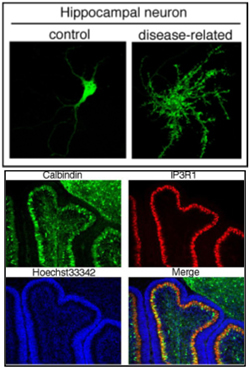(1) Reelin is a secreted protein
that is essential for brain development. We found that
the C-terminal region of Reelin is critically involved
in the association with the target neurons.
(2) We are interested in the effect of disease-related genes in the regulation of neuronal morphology and dynamics. We found that one of the dyslexia-related genes quite robustly induces branching and thorny structures in dendrites of hippocampal neurons.

(3) We take advantage of mutant mice and gene-manipulated mice. By staining with marker antibodies, we are able to locate specific types of neurons in the mouse brain. Combination of these techniques has revealed the specific function of the gene in the brain development.
